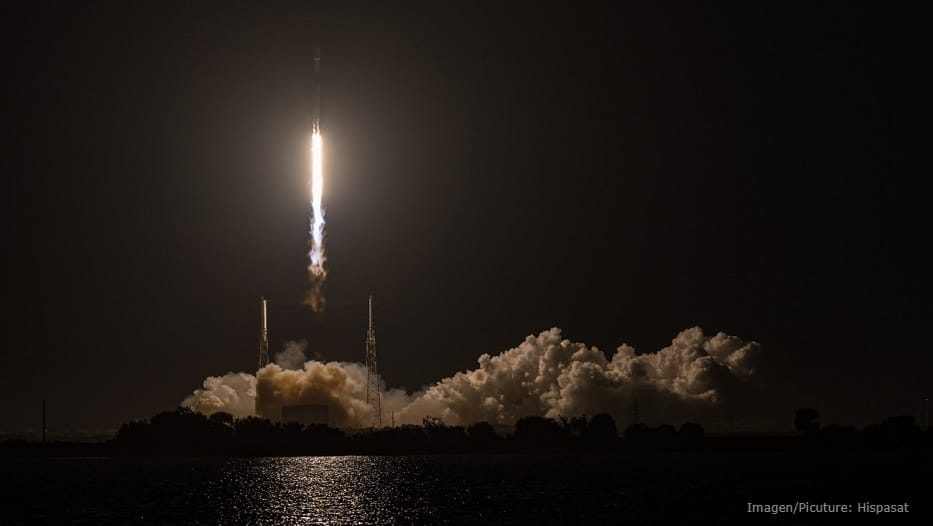Julia Maria Gomez de Avila Segade | 24/08/2023
For more than three decades, MAPFRE has provided coverage not only for the entire Hispasat satellite fleet, but also for the launches, therefore, the relationship of mutual trust is more than consolidated.
On February 6, the 13th satellite in the Hispasat fleet was launched from the facilities in Cape Canaveral, Florida, using SpaceX’s Falcon 9 rocket: Amazonas Nexus. More than 100 days later, Hispasat confirms that it is now operating at full capacity.
Our colleague Cristina Quintero, Deputy Director of Aviation and Transport Underwriting at MAPFRE Global Risks, had the opportunity to attend the launch live. Below, she tells us about her first-person experience.
Experiencing a launch is indescribable. This is a very restricted event, and, for the first time, we were in situ. The weather was perfect, with not a single cloud in the sky, and accompanied by a full moon. Many emotions are mixed in a 35-minute duration. First, the countdown, where your heart goes a mile a minute; then the glow of the ignition of the engines, and the sight of a fireball starting to rise. And then the sound, which comes much later, and is deafening. Both the ground and your entire body vibrate!
Amazonas Nexus has been providing coverage for over 100 days throughout the Americas, the North and South Atlantic corridors, and Greenland, and is specifically designed to reduce the digital divide in Latin America and offer high quality connection on airplanes and ships.
Several stages
The installation of a satellite in orbit involves several stages; the most complex and highest risk for the policy is the launch. Although the reliability of launch vehicles is increasing, any event can occur that may cause the satellite not to reach its destination orbit and, therefore, the need to take out a policy to protect your investment arises.
The launch takes around 30 minutes, and several milestones must successfully occur:
1. Lift-off of the launcher, in this case, the Falcon 9 rocket, consisting of two parts.
2. Separation of the first part (reusable) and ignition of the second part (non-reusable).
3. Separation of the satellite’s fairing and start of operations.
4. First stage recovery and landing on the unmanned maritime platform called “Just Read the Instructions”.
5. Recovery of the two parts of the fairing in the sea thanks to the built-in parachute; an attempt will be made to retrieve them with the support boat.
Gradually, the various milestones of the successful launch are being met: the completion of the first stage and the beginning of the second stage; the recovery of the first stage of the rocket, which returns to the ground and lands on a remote-controlled platform in the sea, some 380 miles off the coast of Florida; the shutdown of the second stage; and finally, the separation of the satellite from its launch vehicle, which concludes the launch. It’s time to celebrate in style. A short time later we are informed that the Amazonas Nexus satellite has already communicated with the ground by telemetry and that everything is working fine. Another celebration!
Final position and operation
Over the next 15 years, the expected life of the satellite, there will be “continuous, real-time monitoring from the control centers”. This is what Víctor Inchausti, head of Hispasat’s Communication team, tells us: “The satellite is currently nearing its final geostationary position and has now entered the in-orbit testing phase, which includes the deployment of the reflectors to verify its correct operation. In a few weeks, the satellite will move to its final position and begin offering services”.
Thanks to this daily control, if a malfunction is detected, the control center personnel are able to send orders to the satellite to correct the orbital position, diagnose a possible malfunction of any component, and accurately divert the operation to other elements on board to respond to these types of incidents.
For Inchausti, the main milestone for Amazonas Nexus is to “respond to the demands of our customers over all these years thanks to the great flexibility provided by its smart digital processor” and, of course, it would also be great news to exceed those 15 years established for the satellite’s useful life. This will be determined by an efficient work in the maneuvers that are performed in orbit during that time. Sooner or later, the end of its useful life will come, and it will be at that moment when the final maneuvers will be made: “The satellite will make a final move to position itself even further away from geostationary orbit, the so-called ‘graveyard orbit’, thus complying with international space law recommendations. Once there, it will shut down, contributing to the sustainability of the satellite business”.
Words of gratitude
To conclude, all that remains for me to say is thatattending a live launch is a once in a lifetime opportunity and I have nothing but words of gratitude to Hispasat for having counted on MAPFRE Global Risks to accompany them in such an important and special moment.

Cristina Quintero,
Aviation and Transport Underwriting Deputy Manager – MAPFRE Global Risks





